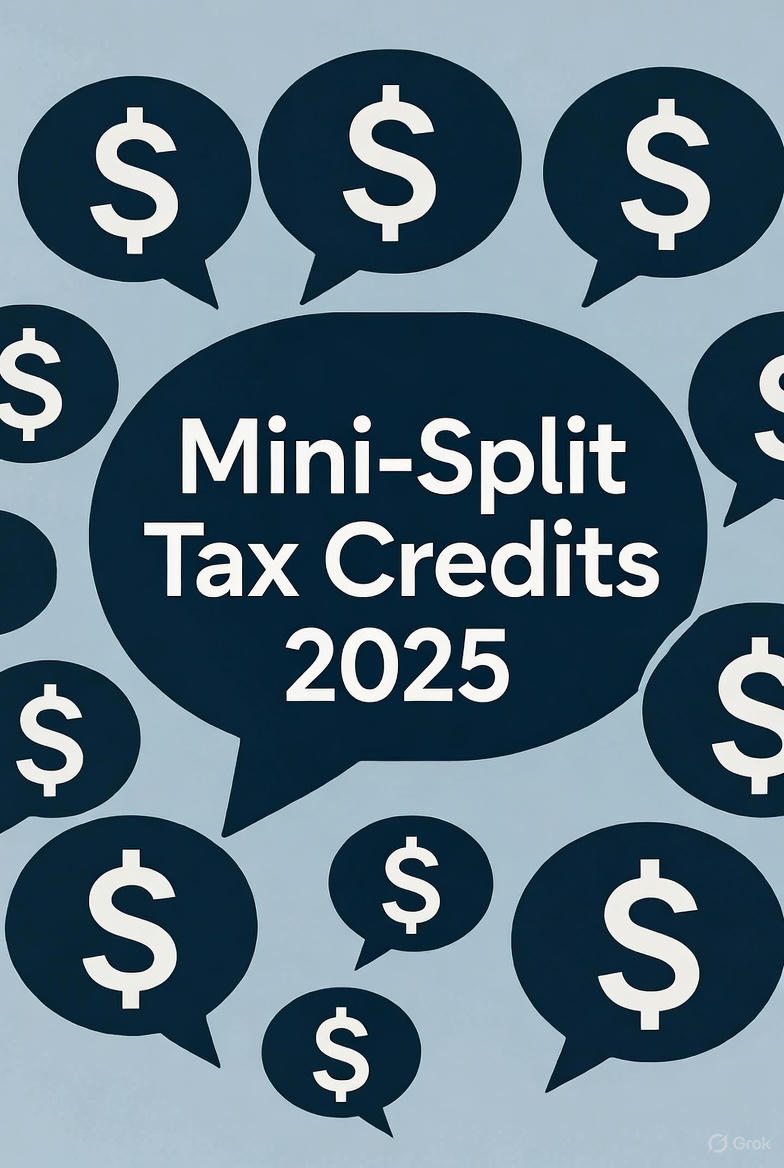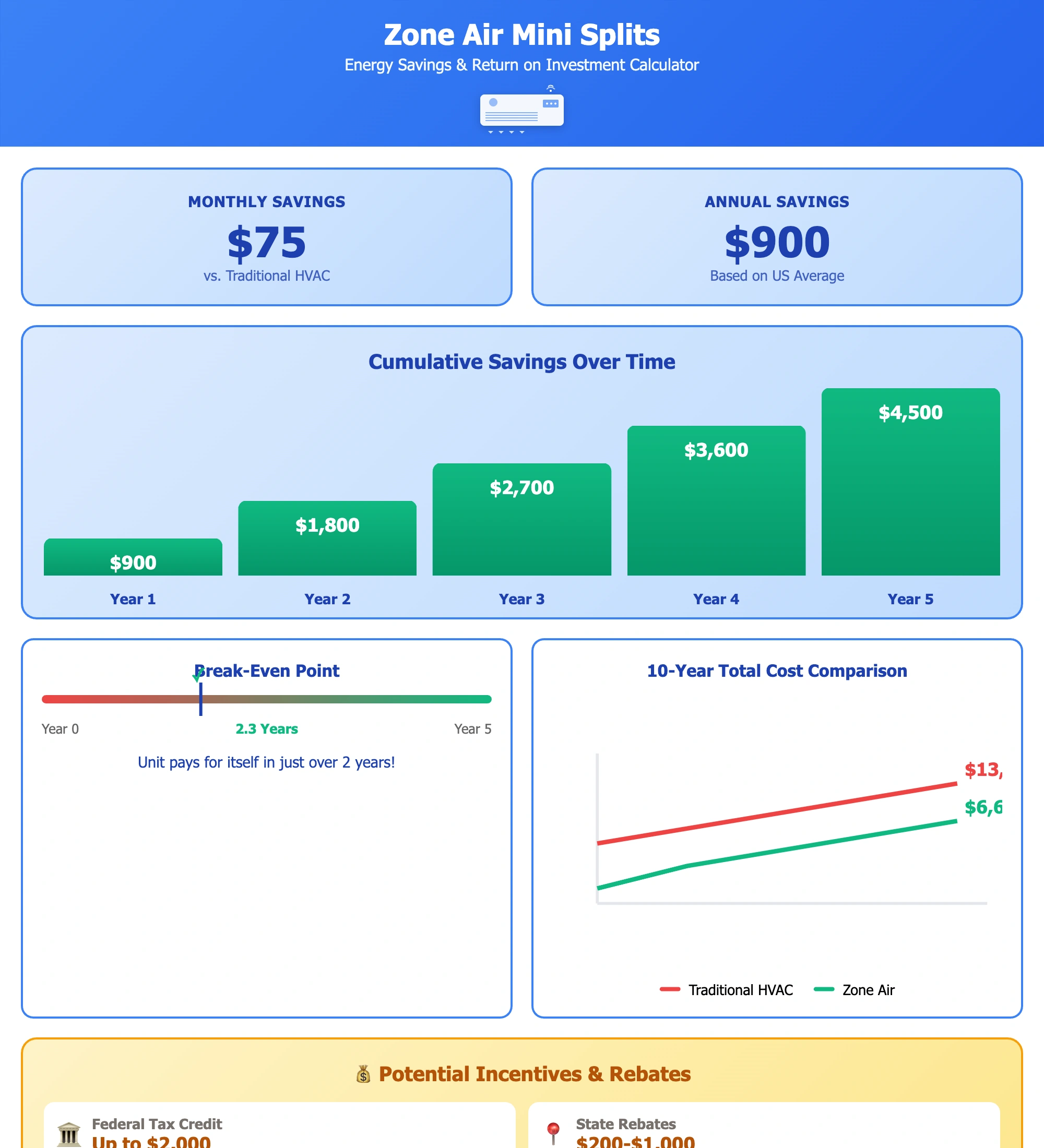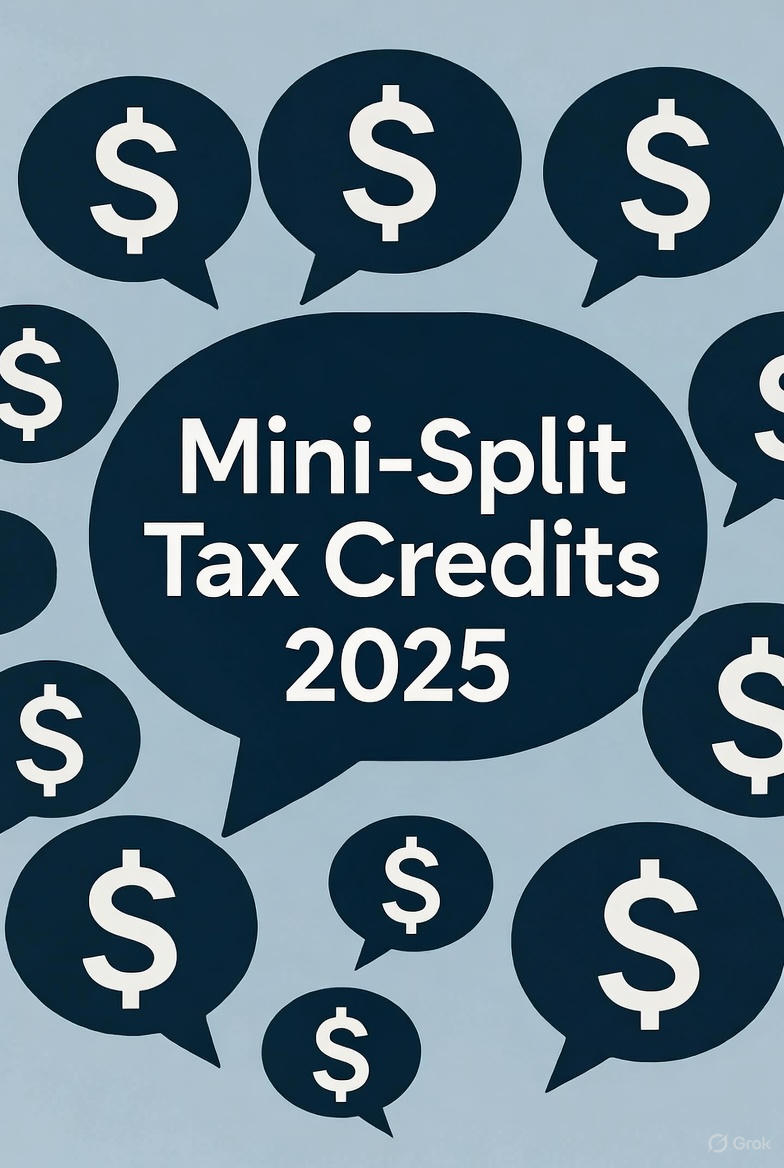When Maria Rodriguez received quotes for her Boston mini-split installation last March, the numbers seemed daunting. Three contractors quoted $4,800-$6,200 for a two-zone system to replace her aging window units and electric baseboards. As a single homeowner on a teacher's salary, she'd been saving for two years but still fell short of the lowest quote. Then her contractor mentioned something that changed everything: "With federal tax credits and Mass Save rebates, your out-of-pocket will be around $1,500—maybe less."
Maria spent an evening researching incentives and discovered she qualified for multiple stacked benefits: a $2,000 federal tax credit under the Inflation Reduction Act, $2,500 from Mass Save's heat pump rebate, and $800 from her utility company. The $5,300 in total incentives transformed her $5,200 installation into an actual cost of -$100—essentially free, with $100 left over. Her first winter heating bill dropped from $340 monthly to $125, saving $215 per month. The system will pay for itself in saved electricity within four months.
But Maria almost missed these incentives entirely. The federal tax credit requires "ENERGY STAR Most Efficient" certification starting in 2025, her utility rebate needed pre-approval before installation, and Mass Save's generous rebates are decreasing in 2026. Timing, proper documentation, and understanding the layered incentive structure made the difference between an unaffordable upgrade and a financially transformational improvement.
This comprehensive 2025 guide explains every available federal, state, and utility incentive for mini-split heat pumps—including critical changes for 2025 installations, exact eligibility requirements, documentation needed, and how to stack multiple programs for maximum savings. Whether you're facing a $5,000-$15,000 installation cost, these incentives can reduce your out-of-pocket by 50-100% if you know how to claim them correctly.
Federal Tax Credit (Inflation Reduction Act)
2025 Program Details:
The Inflation Reduction Act provides substantial tax credits for heat pump installations through December 31, 2025. This program is significantly more generous than the previous Section 25C credit it replaced.
Credit Amount:
- 30% of total project costs
- Maximum: $2,000 per year
- Includes equipment AND installation costs
- No lifetime cap—claim every year through 2025
- Applied to tax liability (non-refundable)
CRITICAL 2025 Change:
Starting January 1, 2025, systems must meet ENERGY STAR Most Efficient certification. This is a higher standard than regular ENERGY STAR:
Standard ENERGY STAR (no longer sufficient):
- SEER2 ≥ 15.2
- HSPF2 ≥ 7.5
ENERGY STAR Most Efficient (required for 2025 credit):
- Must meet Consortium for Energy Efficiency (CEE) highest efficiency tier
- Two pathways available:
- Cold Climate pathway: For heating-dominated applications
- Standard pathway: For cooling-dominated and dual-fuel systems
- Homeowners can choose either pathway regardless of location
Zone Systems Qualification for 2025: All Zone premium systems meet ENERGY STAR Most Efficient requirements:
- SEER2: 22-24 (exceeds requirements)
- HSPF2: 10-12.5 (exceeds requirements)
- ✓ Fully qualified for maximum $2,000 credit
New 2025 Documentation Requirement:
You must report the manufacturer's Qualified Manufacturer Identification Number (QMID) on your tax return. This four-digit code verifies the system was produced by an approved manufacturer. Zone provides QMID codes with all qualifying systems.
Property Requirements:
- Primary or secondary residence in the United States
- Existing home OR new construction (both qualify under IRA)
- Renters making improvements may qualify
- Used as a residence by the taxpayer
How to Claim the Federal Credit:
Step 1: Verify System Qualification
- Confirm ENERGY STAR Most Efficient certification BEFORE purchasing
- Obtain manufacturer's QMID number
- Check energystar.gov for qualified products list
- Zone DIY Series systems include QMID documentation with every purchase
Step 2: Keep All Documentation:
- Itemized purchase receipt showing equipment costs
- Installation invoice with labor costs
- Manufacturer's certification statement
- QMID number (four-digit code)
- Product model and serial numbers
- Installation date proof
- Contractor information and license number
Step 3: File IRS Form 5695
- Complete Part II: "Residential Energy Efficient Property Credit"
- Line 22: Enter total equipment and installation costs
- Line 23: Calculate 30% (multiply Line 22 by 0.30)
- Line 24: Enter maximum allowable ($2,000)
- Transfer credit to Form 1040, Schedule 3
Step 4: Report QMID
- New requirement for 2025 installations
- Enter four-digit QMID on designated line
- Failure to report QMID will disallow the credit
Filing Timeline:
- Claim in tax year of installation (not purchase)
- December 2025 installation → April 2026 tax return
- Keep all documentation for minimum 3 years
Important Credit Limitations:
Non-Refundable Credit:
- Reduces taxes owed to zero, but no refund beyond that
- Example: Owe $1,500, credit is $2,000 → pay $0 (not refunded $500)
- Example: Owe $3,000, credit is $2,000 → pay $1,000
Can Carry Forward:
- If credit exceeds your tax liability, you can carry the unused portion forward to next year
- Helps homeowners with lower tax liability still benefit fully
Annual Cap Structure:
- Heat pumps: $2,000 maximum annually
- Combined with heat pump water heaters and biomass: $2,000 total
- Other improvements (windows, doors, insulation): Separate $1,200 annual cap
- Overall annual maximum: $3,200 total for all energy improvements
State Rebate Programs (2025 Updates)
IMPORTANT: Many state rebate amounts changed significantly in 2025. Some programs reduced funding while others increased incentives. Always check current availability before making purchase decisions.
Massachusetts:
Mass Save Heat Pump Program:
- Standard rebate: Up to $10,000 total for whole-home heat pump systems
- Per-ton rebate: Currently $2,650 per ton (decreasing to lower amounts in 2026)
- Maximum: $8,500 for most installations
- Income-qualified bonus: Additional incentives for eligible households
- Requirements: ENERGY STAR Cold Climate certified, installed by participating contractor
- Financing: Up to $25,000 at 0% interest through HEAT Loan program
- 2025 CRITICAL: Rebates decreasing January 1, 2026 - act before year-end
Mass Save Example:
- 18K BTU system (1.5 ton) = $3,975 rebate
- 24K BTU system (2 ton) = $5,300 rebate
- 36K BTU system (3 ton) = $7,950 rebate (capped at $8,500)
New York:
EmPower+ (Income-Qualified):
- Up to $8,000 in rebates for qualifying homeowners
- Income limits: Varies by household size and county
- Enhanced incentives for disadvantaged communities
- May cover 100% of project costs for eligible households
Con Edison (NYC Area):
- Up to $10,000 for air-source heat pump systems
- Higher amounts for cold-climate certified models
- Must be Con Edison customer
- Pre-approval required before installation
NYSERDA (Statewide):
- Programs vary by region and income level
- Rebate amounts reduced from 2024 levels (was $20K, now typically $8-12K)
- Check nyserda.ny.gov for current program details
- Many programs transitioning to federal HEEHRA funding
California:
Important 2025 Note: California's single-family HEEHRA (Home Energy Efficiency Rebate Act) funding is fully reserved for 2025. Most new applicants will need to wait for 2026 funding or use alternative programs.
Still Available in CA:
Bay Area AQMD (Air Quality Management District):
- $3,000-$4,000 for replacing gas heating
- Bay Area counties only
- Targets air quality improvement
- Limited funding - apply early
Utility Company Rebates:
- PG&E, SDG&E, SCE offer varying rebates ($200-$1,000 typical)
- Self-Generation Incentive Program (SGIP) for battery storage
- Check your specific utility for current offers
TECH Clean California:
- Check current funding status before proceeding
- Programs vary by region
- Some areas still have limited funding available
Maine:
Efficiency Maine:
- Standard: $1,000-$2,000 for heat pumps
- High-efficiency tier: $2,000-$3,500
- Income-qualified: Up to $8,000-$9,000
- Weatherization: May be bundled with other improvements
- One of the more generous and stable programs nationally
Colorado:
Xcel Energy:
- $800-$1,200 per heat pump system
- ENERGY STAR certified required
- Covers Front Range and other service areas
- Additional rebates for evaporative cooler removal

Oregon:
Energy Trust of Oregon:
- $1,000-$2,000 for ductless heat pumps
- Trade ally (approved contractor) installation required
- Additional incentives for manufactured homes
- Income-qualified bonus available
Washington:
Puget Sound Energy:
- $1,200-$2,000 per outdoor unit
- Ductless and ducted systems eligible
- Must be PSE customer
- Energy Smart program enrollment
Statewide Programs to Check:
Over 40 states now offer heat pump rebates through various programs. To find yours:
- DSIRE Database: dsireusa.org - comprehensive database
- State Energy Office: Search "[your state] energy office heat pump rebates"
- Your Utility Company: Check monthly bill for company name, visit their website
- Rewiring America: rewiringamerica.org/app/ira-calculator - IRA incentive calculator
Utility Rebate Programs
Major Utility Examples:
National Grid (Northeast):
- $500-$750 ductless heat pump
- $1,200-$1,500 central ducted heat pump
- ENERGY STAR certified required
ConEdison (New York):
- $500 per ton ductless AC
- $1,000 per ton heat pump
- Cool Choice program
Duke Energy (Southeast):
- $50-$100 per ton (varies by state)
- Smart Saver program
APS (Arizona):
- $300-$450 HVAC rebate
- SEER ≥16
- Residential customers
Austin Energy (Texas):
- $1,200-$1,850 heat pump rebate
- High-efficiency tiers
- Income-qualified bonus
How to Find Your Utility Rebate:
- Check your electric bill for utility name
- Search "[Utility Name] heat pump rebate"
- Call customer service: rebate info
- Visit utility website → Rebates section
Manufacturer Rebates
Zone Promotions:
Zone periodically offers:
- Seasonal sale pricing
- Bundle deals (multi-zone savings)
- Free shipping promotions
- Installation credit offers
Check current offers: zone-air.com
Other Manufacturers:
Mitsubishi:
- $250-$500 seasonal promotions
- Contractor-dependent
Daikin:
- Up to $500 instant rebates
- Varies by model/season
Fujitsu:
- $200-$400 periodic rebates
- Check website for current offers
Note: Zone's everyday pricing typically beats competitors' sale prices.
Combining Incentives
Can You Stack Rebates?
Usually YES:
- Federal tax credit +
- State rebate +
- Utility rebate +
- Manufacturer rebate = Maximum savings
Real 2025 Example Scenarios:
Example 1: Massachusetts (Maria's Actual Case):
Two-Zone 24K BTU System:
- Equipment cost: $3,200
- Professional installation: $2,000
- Total project cost: $5,200
Stacked Incentives:
- Federal tax credit (30% of $5,200): $1,560 (capped at $2,000, so full $1,560)
- Mass Save rebate (2 tons × $2,650): $5,300 (capped at actual project cost)
- National Grid utility rebate: $800
- Total available incentives: $7,660
- Actual incentives claimed: $5,300 (can't exceed project cost plus tax credit)
Net Out-of-Pocket: -$100 (essentially free with $100 savings)
Example 2: New York (Income-Qualified):
Single-Zone 18K BTU System:
- Equipment: $2,400
- Installation: $1,800
- Electrical upgrades: $800
- Total: $5,000
Incentives:
- Federal tax credit: $1,500 (30% of $5,000)
- EmPower+: $5,000 (income-qualified covers remaining)
- Con Edison: $3,000
- Total incentives: $9,500
Net Cost: $0 (fully covered, but limited to project cost)
Example 3: Maine (High-Efficiency System):
Three-Zone 36K BTU Cold Climate System:
- Equipment: $5,500
- Installation: $2,500
- Total: $8,000
Incentives:
- Federal tax credit: $2,000 (30%, capped at max)
- Efficiency Maine (high-efficiency tier): $3,500
- Utility rebate: $1,000
- Total incentives: $6,500
Net Cost: $1,500 (81% savings)
Example 4: Colorado (Standard Installation):
12K BTU Single Zone:
- Equipment: $2,000
- DIY installation: $0 (self-installed)
- Total: $2,000
Incentives:
- Federal tax credit: $600 (30% of equipment only)
- Xcel Energy: $800
- Total incentives: $1,400
Net Cost: $600 (70% savings)
Application Process
Step-by-Step:
1. Before Purchasing (Critical):
Many programs require:
- Pre-approval
- Registered contractor
- Equipment on approved list
- Application before installation
Always check requirements FIRST!
2. Gather Documentation:
You'll Need:
- Purchase receipt
- Installation invoice
- Contractor license info
- Product spec sheet
- Serial/model number
- Installation date proof
- Energy efficiency certifications

3. Application Timing:
Pre-Installation Required:
- Most utility programs
- Many state programs
- Some manufacturer rebates
Post-Installation OK:
- Federal tax credit
- Some state programs
- Manufacturer instant rebates
4. Submit Applications:
Federal Tax Credit:
- File with tax return
- Form 5695
- Keep docs 3 years
State Rebates:
- Online portal usually
- 30-90 days processing
- Check payment in 60-120 days
Utility Rebates:
- Online or mail application
- Attach required docs
- 45-90 days typical
5. Follow Up:
- Save confirmation numbers
- Track application status
- Call if delayed >90 days
- Keep all documentation
Common Mistakes to Avoid
Mistake #1: Not Checking Before Buying
- Some programs have approved equipment lists
- Your preferred model might not qualify
- Always verify eligibility first
Mistake #2: Using Non-Participating Contractor
- Many programs require registered contractors
- DIY may not qualify
- Verify contractor participation before hiring
Mistake #3: Missing Deadlines
- Pre-approval windows
- Installation completion dates
- Application submission limits
- Mark calendars and set reminders
Mistake #4: Incomplete Documentation
- Missing receipts
- No serial number
- Wrong forms
- Use checklist, submit everything
Mistake #5: Not Following Up
- Applications get lost
- Checks lost in mail
- Deadlines to reapply
- Track and follow up at 60 days
Mistake #6: Assuming Retroactive
- Most programs not retroactive
- Already-installed systems don't qualify
- Apply before installation
Mistake #7: Exceeding Income Limits
- Income-qualified programs have strict caps
- Must prove income level
- Check requirements carefully
Income-Qualified Programs
Enhanced Rebates for Low/Moderate Income:
Many states offer enhanced rebates based on income:
Typical Income Limits (% of Area Median Income):
- Low-income: <80% AMI
- Moderate-income: 80-120% AMI
Example (Family of 4, Massachusetts):
- AMI: $115,000
- 80% AMI: $92,000
- If household income <$92,000:
- Standard rebate: $500-$1,250
- Income-qualified: $6,000-$10,000
States with Income-Qualified Programs:
- California
- New York
- Massachusetts
- Connecticut
- Rhode Island
- Maine
- Vermont
- Colorado
- Oregon
- Washington
Documentation Required:
- Tax returns
- Pay stubs
- Government benefit proof
- Income verification form
Benefits:
- Higher rebate amounts
- Sometimes FREE installation
- May include electrical upgrades
- Weatherization included
- 0% financing available
Financing with Rebates
Strategic Approach:
Option 1: Finance Full Amount
- Finance $3,500 (equipment + install)
- Get $1,500 in rebates
- Make lump sum payment
- Reduces principal significantly
Option 2: Finance Net Cost
- Calculate expected rebates
- Finance net cost only
- Use rebates for other efficiency upgrades
Example:
- Total cost: $3,500
- Expected rebates: $1,500
- Finance: $2,000 only
- Monthly payment (5 yrs, 6%): $39
Lender Considerations:
Some lenders offer:
- Rebate assignment (lender gets rebate directly)
- 0% for X months
- Deferred payment until rebate received
2025 vs Future Years
Coming Changes:
Inflation Reduction Act (Passed Aug 2022):
Starting 2023:
- Higher tax credits: Up to $2,000
- No lifetime cap
- Higher efficiency requirements
- New rebate programs: Up to $8,000
Current 2025 Strategy:
If Installing by Dec 31, 2022:
- Claim $300 federal credit
- Won't count against 2025 limits
- Can claim 2025 credits for other upgrades
If Installing 2023+:
- Wait for higher incentives (if possible)
- Or install now and claim future credits for other upgrades

Rebate Finder Tools
Online Resources:
DSIRE (Database of State Incentives):
- dsireusa.org
- Comprehensive database
- Search by ZIP code
- Updated regularly
ENERGY STAR Rebate Finder:
- energystar.gov/rebate-finder
- Enter ZIP code
- Shows federal, state, local, utility
Zone Rebate Finder:
- Call (801) 882-2324
- We'll research your specific area
- Help with application process
Tax Professional Consultation
When to Consult CPA/Tax Pro:
Complex Situations:
- High income (AMT considerations)
- Multiple properties
- Business/rental property
- Self-employed
- Previous credits claimed (lifetime cap questions)
Cost: $100-$300 consultation Benefit: Maximize savings, avoid mistakes
DIY Tax Filing: Most tax software (TurboTax, H&R Block) includes:
- Form 5695 guidance
- Energy credit wizards
- Maximization suggestions
State-Specific Deep Dives
California (Highest Incentives):
Available Programs:
- TECH Clean California: $500-$6,500
- AQMD (9 counties): $3,000
- Utility rebates: $200-$1,000
- Federal credit: $300
Maximum Combination: $10,000+
How to Access:
- Check TechCleanCA.org
- Find participating contractor
- Apply before installation
- Contractor handles paperwork
- Rebate as bill credit or check
New York (Second Highest):
Available Programs:
- NYSERDA: $1,000-$1,500/ton
- ConEd/NG rebates: $500-$1,000
- Federal credit: $300
Maximum: $3,000-$4,000
Process:
- Find NYSERDA contractor
- Contractor submits application
- Approval before installation
- Rebate check 60-90 days
Other High-Incentive States:
- Massachusetts: Up to $10,000
- Maine: Up to $8,000
- Vermont: Up to $5,000
- Connecticut: Up to $4,000
- Oregon: Up to $3,500
Bottom Line
Average Savings Potential:
National Average:
- Federal: $300
- State: $500-$1,000
- Utility: $200-$500
- Total: $1,000-$1,800 (30-50% of cost)
High-Incentive States:
- Federal: $300
- State: $1,500-$3,000
- Utility: $500-$1,000
- Total: $2,300-$4,300 (50-100%+ of cost)
Action Plan:
-
Research (1-2 hours)
- DSIRE database
- Utility website
- State energy office
- Zone rebate finder
-
Verify Eligibility (1 hour)
- Equipment qualifications
- Property requirements
- Contractor requirements
-
Pre-Apply if Required (1 hour)
- Some programs need pre-approval
- Get confirmation before purchasing
-
Purchase & Install (1-2 days)
- Keep all documentation
- Get required certifications
-
Apply for Rebates (2-3 hours)
- Submit all applications within 30 days
- Follow up at 60 days
-
Claim Tax Credit (1 hour)
- Complete Form 5695
- File with tax return
Total Time Investment: 6-9 hours Average Return: $1,000-$4,000 Hourly Rate: $110-$650/hour
Worth it? Absolutely.
Frequently Asked Questions
Does my mini-split qualify for the federal tax credit in 2025?
Your mini-split qualifies for the 2025 federal tax credit if it meets three requirements: it must be an air-source heat pump (provides both heating and cooling), it must have ENERGY STAR Most Efficient certification (higher than standard ENERGY STAR), and the manufacturer must provide a Qualified Manufacturer Identification Number (QMID). The ENERGY STAR Most Efficient requirement is new for 2025 and represents the highest efficiency tier from the Consortium for Energy Efficiency. Standard ENERGY STAR certification is no longer sufficient. All Zone premium mini-split systems meet these requirements and include QMID documentation. The credit provides 30% of total project costs including equipment and professional installation, capped at $2,000 annually. Cooling-only units do not qualify—the system must be a heat pump. Check energystar.gov for the current list of qualifying products, or verify with your manufacturer before purchasing.
Can I claim both federal tax credits and state rebates for the same system?
Yes—you can absolutely stack federal tax credits with state and utility rebates for the same mini-split installation, and doing so maximizes your total savings. The IRS allows combining the federal tax credit with state rebates, utility rebates, and even manufacturer promotions. For example, Massachusetts homeowners routinely claim the $2,000 federal credit plus $5,000-$8,500 from Mass Save plus $500-$1,000 utility rebates, totaling $7,500-$11,500 in combined incentives. These incentives come from different sources (federal government, state programs, utility companies) so there's no conflict. However, be aware that rebates may reduce your qualified costs for the federal credit calculation in some cases—consult IRS Form 5695 instructions or a tax professional for your specific situation. The key is applying for everything you qualify for, as these programs are designed to be stackable to maximize adoption of energy-efficient systems.
What happens if I don't have $2,000 in tax liability to claim the full credit?
The federal tax credit is non-refundable, meaning it can only reduce your tax liability to zero—it won't generate a refund beyond what you owe. If you owe $1,200 in federal taxes and qualify for a $2,000 credit, you'll pay $0 in taxes but won't receive an $800 refund. However, good news: the IRA allows carrying forward unused credit to future tax years. If you can only use $1,200 of your $2,000 credit this year, the remaining $800 carries forward to next year's return, where it can offset future tax liability. This makes the credit valuable even for homeowners with lower incomes or significant deductions. Additionally, state rebates provide cash back or bill credits regardless of tax situation, so you'll still benefit substantially from state and utility programs even if you can't fully utilize the federal credit. If you're uncertain about your tax situation, consult a tax professional before installation to understand your specific benefit.
Do I need to hire a professional installer to qualify for rebates?
Federal tax credit requirements vary—the IRS allows DIY installations for the federal credit, though you can only claim equipment costs (not labor you didn't pay for). However, most state and utility rebate programs require licensed, professional installation by participating or approved contractors. For example, Mass Save requires installation by a Mass Save participating contractor, NYSERDA requires approved contractors, and most utility programs have similar requirements. Even if you're technically skilled, installing DIY will disqualify you from state/utility rebates worth $1,000-$10,000, far exceeding the $500-$2,000 you might save on installation labor. Our recommendation: use professional installation for maximum incentive eligibility. If you're in a state without rebate programs or they're already exhausted, DIY can make sense and you'll still qualify for the federal credit. Check your specific state and utility requirements before deciding—the rebate eligibility usually makes professional installation the financially superior choice.
When do I need to apply for rebates—before or after installation?
Timing is critical and varies by program, so you must check requirements for each incentive before proceeding. Most state and utility rebate programs require pre-approval or application BEFORE installation—installing first will disqualify you from these rebates entirely. For example, Mass Save, NYSERDA, and most utility programs require submitting applications and receiving approval before beginning work. The federal tax credit is different—you can claim it after installation when filing taxes, no pre-approval needed. Manufacturer rebates usually require registration within 30-60 days of purchase. The safest approach: (1) research all available programs for your location, (2) apply for state/utility rebates first and wait for approval, (3) purchase and install system, (4) submit post-installation documentation to rebate programs, (5) claim federal credit when filing taxes. Never assume you can apply retroactively—one homeowner lost $6,000 in state rebates by installing two weeks before applying. When in doubt, apply first.
Are rebates and tax credits only for replacing old systems, or do new installations qualify?
Both replacement and new installations qualify for federal tax credits under the Inflation Reduction Act—unlike the old program, there's no requirement that the home be existing construction. Whether you're replacing old window units, upgrading from electric baseboards, converting from gas heating, or adding climate control to a previously unconditioned space, you qualify for the federal credit as long as the system meets efficiency requirements and is installed in a residence you own. State rebate programs vary more widely—some prioritize replacements of fossil fuel heating (natural gas, propane, oil), some focus on equity and income-qualified households, while others support any efficiency upgrade. California's TECH Clean California specifically targets gas heating replacement, while Massachusetts Mass Save rebates apply to most installations regardless of what you're replacing. A few programs offer enhanced rebates for replacing fossil fuel systems. Check your specific state program requirements, but in general, both new installations and replacements qualify for most programs.
What is the deadline for the 2025 federal tax credit?
The federal tax credit under the Inflation Reduction Act is currently authorized through December 31, 2025. Any mini-split heat pump system placed in service (installed and operational) by this date qualifies for the 30% credit up to $2,000. Systems installed January 1, 2026 or later currently have no federal tax credit unless Congress extends the program—which is possible but not guaranteed. Your filing timeline: December 2025 installation is claimed on your April 2026 tax return (the return covering the 2025 tax year). Many state rebate programs are also winding down or reducing amounts in 2026—Massachusetts Mass Save explicitly announced rebate reductions effective January 1, 2026. If you're considering a mini-split within the next 2-3 years, installing by December 31, 2025 maximizes available incentives. Don't wait for possible extensions—a system that costs $5,000 installed could cost $7,000-$12,000 after 2025 without these incentives. The combination of federal, state, and utility incentives available in 2025 may represent the best opportunity for heat pump rebates for many years.
Need help identifying available rebates in your area? Contact Zone at (801) 882-2324 or check our current rebates page for 2025 programs.
About the Author: Thomas Johnson is a Sales & Customer Success Specialist at Zone Air with a background in business and competitive strategy. Drawing from his experience in rugby, where teamwork and strategic planning are essential, Thomas applies the same principles to helping customers find the perfect HVAC solution for their needs. He specializes in product comparisons, brand analysis, and matching customers with systems that deliver the best value for their specific situation. Thomas's consultative approach ensures customers understand their options clearly and make confident purchasing decisions. When not helping homeowners upgrade their comfort, you'll find him on the rugby pitch developing the same strategic thinking he brings to customer consultations.


